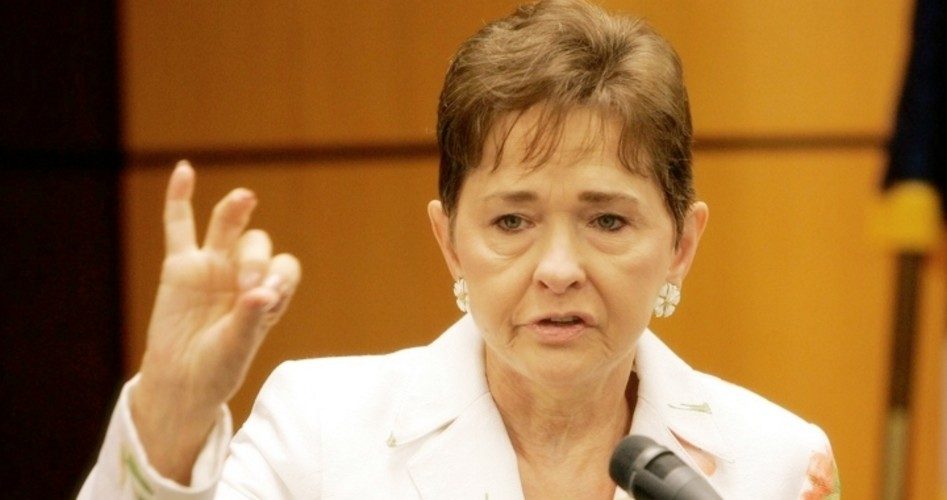
North Carolina Representative Sue Myrick (R) has been very vocal in warning of a Hezbollah presence in Mexico, and in urging the Department of Homeland Security (DHS) to step up surveillance of terrorists there. She joins a host of concerned Americans who are worried about the porosity of the nation’s southern border — and continually cautions that border issues aren’t just about immigrants seeking a better life, but about easy access that terrorists have to America.
In June, 2010, she penned a letter to DHS Secretary Janet Napolitano requesting the establishment of a task force to “engage US and Mexican law enforcement and border patrol officials about Hezbollah’s presence, activities and connection to gangs and drug cartels.”
Indeed, a year later, the American Enterprise Institute for Public Policy Research, in October, 2011, released a report concluding that Hezbollah “is using the Western Hemisphere as a staging ground, fundraising center, and operation base to wage asymmetric warfare against the United States.” Entitled The Mounting Hezbollah Threat in Latin America, the report also pointed out that “evidence indicates Hezbollah is sharing its terrorist experiences and techniques with Mexican drug cartels along the US border.”
And just two weeks ago, Mansour Arbabsiar, a naturalized U.S. citizen holding both Iranian and U.S. passports, pled guilty in New York for plotting to pay a Los Zetas cartel (also a DEA informant) hitman to assassinate a Saudi Arabian ambassador to the United States. Fox News reported, “‘A little more than a year after his arrest, Mansour Arbabsiar has admitted to his role in a deadly plot approved by members of the Iranian military to assassinate a sitting foreign ambassador on U.S. soil,’ Attorney General Eric Holder said in a press release.”
Fox News also reported that in the fall of 2010 the Tucson Police Department cited the arrest of Jameel Nasar, who attempted to establish a Hezbollah network in Mexico and in South America. And during the previous year — after Jamal Yousef was arrested in New York City — it was learned that weapons stolen from Iran by Yousef’s cousin, an alleged Hezbollah member, were stored in Mexico.
But even after Myrick’s letter to Napolitano, the Secretary said there was no need for a task force, as current intelligence resources were adequate. Napolitano also claimed in 2011 that, “The border is better now than it has ever been.”
However, Borderland Beat reported on September 10, 2012 of the arrest of a suspected American Hezbollah supporter in Merida, in the Yucatan peninsula. Rafic Mohammad Labboun Allaboun is an imam from the Shiite Association Bay Area mosque in San Jose, California, and was arrested with two others, from Belize, suspected of being part of an Islamic terror cell operating in central America and the Yucatan. The report added that Merida has a large Lebanese and Syrian population.
Fox added a remark from Arizona Governor Jan Brewer’s office — “’The Arizona Department of Homeland Security has indicated there are elements of Middle Eastern Islamic extremist groups operating in Mexico,’ said Matthew Benson, Director of Communications for Brewer. ‘From the governor’s standpoint, it is critical to have a secure border for criminal elements who would take advantage of a porous border, especially like the one we have in Arizona.’ “
Myrick has repeatedly warned of a Hezbollah presence in Mexico and said she’s concerned about discussion of terrorism in the Middle East while ignoring potential threats in Mexico. “Given the evidence available, it only makes sense that DHS should, at the very least, investigate the presence of Hezbollah along our Southern border, regardless of who is in office.”
Remarkably, Texas Governor Rick Perry, whose state has the largest segment of the nation’s southern border, maintains a contradictory position on the issues. While he mentioned in last year’s presidential debate that, “We’re seeing countries start to come in and infiltrate. We know that Hamas and Hezbollah are working in Mexico as well as Iran with their ploy to come into the United States,” he continues to take a less-than-tough stance on illegal immigration. From signing into law a tuition break for illegal immigrants to his abysmal sacrifice of Texas’ sovereignty to his goal of building the Trans Texas Corridor “connecting the Texas cities and towns along the proposed I-69 route to the industrial heartland of Mexico, and the industrial base of Middle America,” his actions belie his words. No other project could lay out the welcome mat to terrorists as prominently as Perry’s Corridor project.
Sue Myrick will be retiring at the end of the 112th Congress, in January 2013.
Photo: Rep. Sue Myrick (R-N.C.) answers a question during a news conference in Charlotte, N.C., back on July 17, 2006: AP Images



